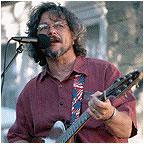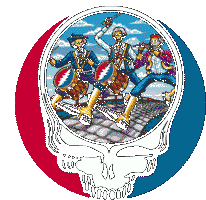20 Questions with David Gans



from Jambase
There are some folks just woven into the musculature of certain music. David Gans has expanded our enjoyment and understanding of the Grateful Dead's music for decades. His books Playing in the Band: An Oral and Visual Portrait of the Grateful Dead and Conversations with the Dead are two of the few essential works in a large but often empty library about the band. He's been the host of the nationally syndicated radio program The Grateful Dead Hour, which just celebrated its 20th anniversary, and he also produces Dead To The World on KPFA radio in the Bay Area. But there's far more to Gans than a lurker on the edges of Dead territory. A gifted singer-songwriter, respected music journalist, inventive entrepreneur, and trickster in the archetypal sense, Gans vibrates with a love of things musical, which in turn inspires our own pleasure and feeling for sound and vision.
He began making his own music around the San Francisco region in 1970 but transitioned into writing about music as the decade progressed. He contributed to legendary free paper BAM and was an editor at both Mix magazine and Jann Wenner's short-lived Record magazine. He was also instrumental in setting up the BASS ticketing system nationwide, something that made obtaining tickets infinitely easier for tour-obsessed Heads. In the mid-90's after the passing of Jerry Garcia, Gans returned to making his own music, which carries echoes of the Dead's work but also has a playful character and wiggly organic shake that is wholly its own. In the past decade, he's become a staple of the festival circuit and can often be found in coffee houses living the folk singer life – a contemporary bard telling us tales to make us weep and snicker.
David took time from his always-hectic schedule to talk with us about his career, the Dead, and more. Pull up a chair, pour yourself something sweet, and bend an ear to a trooper who's been in the trenches fighting the good fight for more than 30 years.
1. Not many make the transition from being a musician to being a music writer. What has being on both sides of this proverbial fence taught you about making music?
Oh, countless things. I just sort of wandered into the writing thing in the mid-'70s, when BAM magazine started here in the Bay Area, and found myself interviewing all sorts of interesting people - not just musicians but also producers and engineers and legendary inventors like Les Paul and Leo Fender. It was a million-dollar education!
2. What was the first Grateful Dead song to really flip your wig?
There were several identifiable scraps in the smoking crater of my mind after that first show (March 5, 1972). I later figured out that they were "Greatest Story Ever Told," "Bertha," and "Black-Throated Wind." Plus they played "Good Lovin'," and although I was as far away from the stage as you could be (in the last row of the high part of the balcony of Winterland), I got at least an inkling of what Pigpen was capable of. Unfortunately, that was the only time I saw him.
3. Tell us about Truth And Fun, Inc. Where'd the name come from? Why organize your business dealings under such a banner?
"Truth and Fun" was a phrase I came up with in the late '70s or early '80s, a sort of philosophical shorthand, or my version of the golden rule. I figure those are two things you want to keep in balance - if you're having fun at the expense of the truth, or if the truth isn't any fun, then something needs to change. I had those words on my letterhead when I was a freelance writer. In 1988, the Grateful Dead asked me to incorporate before entering into a contract with GDP and a radio syndicator. I decided to call the company "Truth and Fun, Inc." It gets a lot of comments, all of them favorable.
4. There's a kind of ancient vibe to singer-songwriters, something that ties into bards and other traveling storytellers. Do you ever feel this kind of ancient connection?
Garcia & Lesh by Jay BlakesbergI grew up listening to AM radio and then "underground" FM in the '60s. That was a really rich variety of music, before everything was segmented by genre, skin color, and other factors. I didn't have much sense of the roots of the music I loved until much later, when people like Jerry Garcia and Bob Dylan pointed explicitly to the great musicians who influenced their creative personalities. I am much more aware of my place in a centuries-long line of bards and troubadours now than I ever was when I was younger. I don't know that it makes all that much difference in how I work or what I do though. I have only rarely done that great Hunter-Dylan-Shakespeare thing of revisiting a classic motif and dressing it in new clothes. I wish I had that much control over my creativity, to tell you the truth.
5. You've done nearly 900 Grateful Dead Hours. How do you keep it interesting to yourself after all these years? What keeps moving you to create this audio space every week?
Actually, I've produced more than a thousand hours. I started numbering them in 1987, after more than two years on KFOG. I did 55 "Deadhead Hours" before Grateful Dead Hour #1, the new name having been instituted by the syndicator who distributed the show from Labor Day 1988 to Labor Day 1989.
I've never gotten anywhere close to bored with my day job. To the people who understand and appreciate it, Grateful Dead music is endlessly fascinating. I jump around from era to era, doing my best to cover every period of Grateful Dead evolution, and I'm always on the lookout for more great new music as well. Keeping up with the new archival releases from Grateful Dead, the Garcia estate, and other sources is another enjoyable part of the adventure.
6. Dead to the World, your weekly program on KPFA, ranges into bands other than the Grateful Dead and their offshoots. What criteria do you use to decide who makes the cut, who has the right vibe for what you're trying to do?
David Gans by Tony BittickI trust my ears and my instincts. I hear a lot of good music at the festivals I play, and people send me new music all the time too. I also get ideas from friends and colleagues. Richard Gehr, a writer in New York, and Barry Smolin at KPFK, have both turned me on to a lot of fine music. I also hear from listeners, and I learn a lot in my online hangout, The WELL.
7. A lot of folks don't fully appreciate what it takes to live life on the road and literally sing for one's supper. What wisdom, hard and soft, have you gleaned from touring?
Oh, that's a big question. I can carve out a little piece it for you.
I have been fortunate in that I don't think I've had to learn a lot of "hard lessons." Although I have been a musician for decades, I have only been touring for about eight years. I have a stable and satisfying home life and some very healthy living habits that I have acquired over time, and I do my best on the road to maintain a wise lifestyle. I don't eat junk food, I don't drink alcohol, I get a good night's sleep, and I try to get some exercise along the way.
Regarding the artistic and business side of the question, I do my best to deliver a good performance every time. When I'm opening for another artist, I don't take it personally if their audience isn't as attentive as I'd like. And if I'm headlining, I try not to freak out too much if the attendance isn't as high as the venue (and I) expected or hoped for. I am loyal to the people who treat me well, and I am grateful to anyone and everyone who listens to the music I make and to those who support me in my work.
8. So much of your creative output is associated with the Grateful Dead. In what ways is your own music similar to the Dead and in what ways is it different?
Gans & Lesh by MinkinThere's Grateful Dead in every note I play, just about, because there was a time in the '70s when all I wanted to do was learn how to play like that. But I was a songwriter and a guitar player and singer before I ever heard of the Grateful Dead, and there are any number of artists and styles I have studied before and since becoming a Deadhead. Someone else will have to tell you how much my songs sound (or don't sound) like Grateful Dead songs, because I honestly can't tell from here. Every song I write has its own weird path from inspiration to completion, and the muse doesn't much care for protracted arguments. I take what I can get.
9. What are your thoughts on the various post-Garcia aggregates like Ratdog, Phil Lesh & Friends, and most importantly, The Dead, which includes all the surviving Grateful Dead members?
Bob Weir with Ratdog by Susan J. WeiandI am glad those guys are continuing to make music, and I don't have strong feelings about whether or not they make it together. Obviously, they traveled a long road together, and there were many bumps along the way. It's been said (in Phil's book, for one) and I have observed that the bonds between Jerry and everyone else were much stronger than the bonds among the other band members. It's possible they just didn't have that much interest in continuing their collaborations after Jerry's passing.
I'm a big fan of Ratdog since Robin Sylvester joined the band. Rob Wasserman is a fine musician, but Robin is much better suited to the role of bassist in that band, and the proof is in the music they've been making for the last couple of years.
And I'm very happy to see Phil Lesh continuing to mix it up, and to see him choosing some of my favorite musicians (and friends): Tim Carbone, John Skehan, and Andy Goessling of Railroad Earth; Barry Sless of the David Nelson Band; and Al Schnier of moe.



0 Comments:
Post a Comment
<< Home